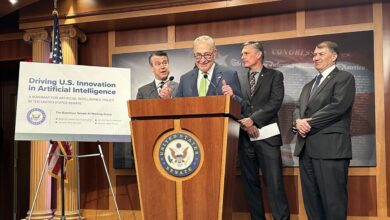Artificial Intelligence is killing art – Northern Iowan

You’re scrolling through your favorite social media app when you stumble across some digital artwork that someone has posted. At first glance the piece is beautiful, depicting a realistically drawn woman with gorgeous scenery, covering the image in a beautiful array of colors. But as you start to look closely, you notice something seems off: the hands of the woman are misshapen, lines don’t connect or run off, and the shading and lighting are all over the place. You realize what you are looking at is AI art.
AI, short for artificial intelligence, boils down to the science of making machines that can think like humans. The term artificial intelligence was coined in the 1950s, where the first form of machine intelligence was created and strongly marked due to technological developments during World War II.
The development of artificial intelligence went through many ups and downs over the last few decades, but it wasn’t until 2017 that AI started to gain traction due to Google’s implementation of it into their search engine. By the 2020s, generative AI became the new trendy thing, with companies making websites that people could access and create their own AI generated images, text and videos.
The rise in AI art doesn’t just affect small creators and their passion for art; it is beginning to stretch into big industries involving music, movies, video games, books and much more. This begs the questions: will AI soon replace all creative aspects of media? Will creative jobs become nonexistent?
The concept of creating art from AI popularized in 2021 when the company OpenAI created the first rendition of a program called DALL-E, where users could input a prompt into the system and it would generate multiple images of said prompt.
The sight was primitive at first, its image generation obviously lacking a human touch due to its distortion and odd shapes and lines that generated in these images. It wasn’t until 2023 that internet consumers started to notice that AI art was evolving.
Machine generated images went from being easily detectable by the average person to almost indistinguishable from real art, taking someone familiar with AI to differentiate.
As the DALL-E system released it’s newest AI called DALL-E 3 in August of 2023, the advancement in the technology has allowed AI art to start not only generating extremely realistic images, but also mimicking different art styles. From recreating a renaissance painting to imitating a unique art style, AI can now create anything with a single prompt.
This evolution of AI art is striking fear into real artists, especially digital ones.
Not only is AI art not drawn by real human artists, but the way it achieves these art styles is by people actively stealing and putting real artists’ work into these programs.
The AI then learns this style through its complex database, and then can recreate it almost perfectly. The people who feed these databases are stealing other people’s creative and unique styles that have taken years of practice to develop, and are also creating tension and fights within the art community. Many digital artists are now being accused of using AI to create their art, even if that is not the case. Back in January of 2023, an artist was banned from a Subreddit called r/Art, which is a specific community on Reddit where people can share the art they create or discuss their favorite art. A moderator of this website banned this Vietnamese artist named Ben Morgan for his piece titled “A Muse in Warzone,” saying his piece looked AI generated and told the creator to “find a different style.”
The rise in AI art doesn’t just affect small creators and their passion for art; it is beginning to stretch into big industries involving music, movies, video games, books and much more. This begs the questions: will AI soon replace all creative aspects of media? Will creative jobs become nonexistent?
We can already see it happening in other parts of the world such as China, where over 70% of video game illustrators lost their jobs in 2021 due to a variety of reasons, the biggest one being the AI boom according to Leo Li, a gaming industry recruiter in Hangzhou, China. The takeover of AI is creeping up on the American doorstep as well, with big name companies like Disney. The corporation has been accused of using AI on multiple occasions in their promotions, such as the poster for season two of their Marvel TV show “Loki,” or their 2023 Thanksgiving post of Mickey Mouse and the gang recreating the painting “The Thanksgiving Picture” by Norman Rockwell.
In the music industry, people are creating lyrics and instrumentals using generative software. Book covers and even entire books are being generated with only a few clicks from an actual human being.
But artists aren’t sitting down quietly and letting AI take over their livelihoods. In October of 2023, there were developments of a model that “poisons” the data in these generative AI softwares. This tool, called Nightshade, messes up the learning models and training data in the programs by training them to generate worse images, or even completely wrong images that weren’t in the initial prompt. This device was created by Ben Zhao, a professor at the University of Chicago, and works by changing the pixels of images in subtle ways that are invisible to human eyes but manipulates machine-learning models into interpreting the image as something different.
Small patterns, small changes in colors, these changes can break almost any generated AI software, and artists are celebrating. The destruction of all these different softwares would make it less likely for artists to lose their jobs to AI and allow creative jobs to continue flourishing in this ever-increasing automated world.
As we navigate this balance between human art and technological creation, the future of art is still undecided. Will AI become the dominant force in creative expression, or will human creativity prevail against the force that is automation? Only time will tell. But one thing remains certain: the human spirit of art still endures, and will not go down lightly by the lurking shadows of artificial intelligence.



